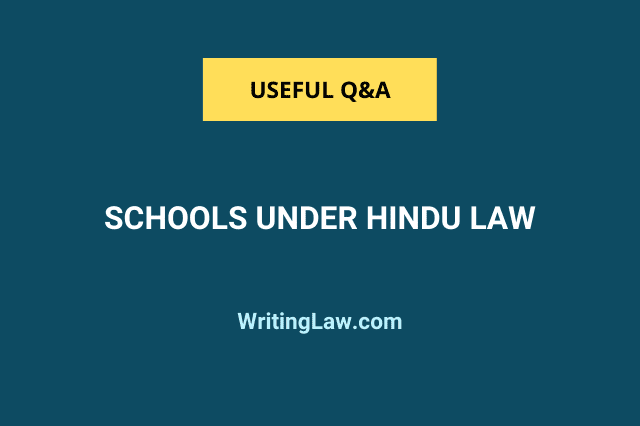
In this post, you’ll study the two main schools under Hindu Law: Mitakshara School and Dayabhaga School. Later, you’ll also briefly know about the four sub-schools: Benaras School, Mithila School, Bombay School and Madras School.
1. What Is Mitakshara School Under Hindu Law?
Mitakshara is the school of Hindu Law that owes its name to the Vijnaneshwara Commentary. It prevails over the whole of India except Bengal and Assam. Also, it prevails in Bengal and Assam on all those matters on which the Dayabhaga School of Law is silent.
Mitakshara, in terms of the law of succession, is based on the principle of propinquity, which is the nearest blood relation. It excludes females from inheritance and is based on agnates over cognates.
- Propinquity means the state of being close to someone or something; proximity; close kinship; affiliation.
- Agnate means a person descended from the same male ancestor.
- Cognate means a blood relative, especially on the mother’s side.
- Related: Important Words, Terms and Phrases of Hindu Law
As per the Mitakshara School, sons have a right by birth in the joint Hindu family property, and the interest of each coparcener is fluctuating, as death may augment it and birth may diminish it. Also, neither the father nor any other coparcener has a right to alienate joint family property.
Related Law Note: Male and Female Succession under Hindu Succession Act, 1956
2. What Is Dayabhaga School Under Hindu Law?
Another main school of Hindu Law is the Dayabhaga School, which owes its name to the Jimutavahana digest. It prevails in Bengal and Assam and deals only with partition and inheritance.
Dayabhaga School is based on principles of religious efficacy of spiritual benefit and does not lead to agnates over cognates. Under this school of Law, no such birthright in terms of succession is given to the son.
Also, there is a specified and ascertained share in the joint family property, and interest does not fluctuate on birth or death. The coparcener has full right to alienate his undivided share in a joint family property, unlike the Mitakshara School of Law.
Sub-Schools of Hindu Law
Basically, these are the schools under the subcategory of main schools and were followed in small regions. There are four such sub-schools under Hindu Law. These are:
1. Benares School
This school extends to the whole of north India except rural Punjab, and the main authorities are Virmitrodaya and Nirnaya Sindhu.
2. Mithila School
This school extends to Tirhut and certain districts of northern Bihar.
3. Bombay School
This school extends to western India, including the whole presidency of Bombay as well as Berar.
4. Madras School
This school extends to southern India, including the presidency of old Madras.
Under the Hindu Succession Act, 1956, one uniform law of inheritance belongs to all Hindus, irrespective of whatever schools or sub-schools they may belong to.
Read Next:
1. What Is the Procedure of Registration of Hindu Marriages in India?
2. List of Important Sections of Hindu Law
3. What Is Criminology and Four Important Schools of Criminology?
- What Are the Rights of Private Sector Employees in India? - 4th April 2023
- Is an Unmarried Woman Legally Allowed To Have an Abortion in India? - 27th June 2022
- What Are the Two Main Schools and Four Sub-Schools Under Hindu Law? - 27th April 2022







